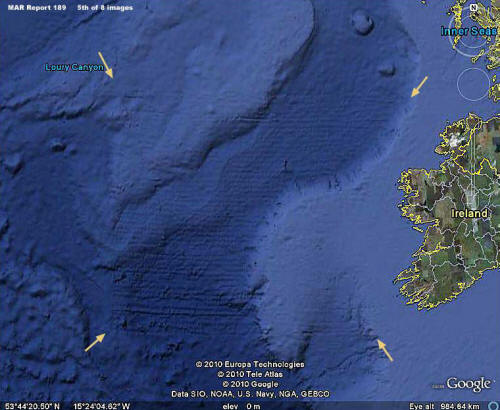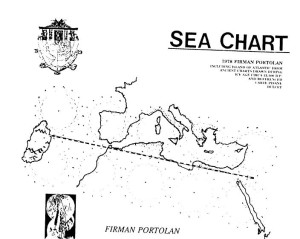Ice Age
9,000
9,000 is arguably the most important number in Plato’s Atlantis narrative. It is found in Critias 108e describing the number of years between the war with Atlantis and the time of Solon’s visit to Egypt. However, in Timaeus 23e it is also given as the number of years since the foundation of Athens.
Taken at face value, it implies that around 9600 BC Atlantis launched an attack on Athens and Egypt. However, archaeologically this makes no sense as the is no evidence of structured societies at either location until many thousands of years later.
Nevertheless, it should be noted that when Greek numerical notation was developing, 9,000 was the largest value that could be expressed by a single character. Later, it was sometimes used to describe a large but indefinite amount. A Bible study site tells us that “The use of definite numerical expressions in an indefinite sense, that is, as round numbers, which is met with in many languages, seems to have been very prevalent in Western Asia from early times to the present day.”(a)
This apparent contradiction has baffled commentators for centuries. The ancient Egyptians had three calendars, solar, lunar and seasonal. As the solar years made little sense, attention turned to the lunar calendar used for religious purposes, keeping in mind that Solon received the Atlantis story from priests. Dividing 9,000 lunar cycles by 13 gives us around 692 solar years or circa 1300 BC for the war with Atlantis, which in isolation is more credible.
However, there are many other large numbers used by Plato in the Atlantis narrative relating to the military strength and dimensions of architectural features, which also seem to be exaggerations and, in my opinion, are all seeingly inflated to a similar degree! As I see it, there are two possible solutions. Either the numbers are the result of a variety of unrelated translations and/or transcription errors or we must consider the possibility that there is a single explanation for all the apparent anomalies. Reluctantly, I have suggested ‘factor ten‘ as the most likely solution.
>However, there are other details in the Atlantis narrative that conflict with this early date for the war with Atlantis. Plato clearly states  that following the submergence of Atlantis its remains lay in shallow waters creating a maritime hazard and continuing to remain a danger to shipping until at least Plato’s time (Tim 25d). Since 9600 BC saw the ending of the last ice age, sea levels have risen 400 feet since then with minimal increases during the last couple of millennia. Shallows created in 9600 BC could not have lasted until Plato’s day.<
that following the submergence of Atlantis its remains lay in shallow waters creating a maritime hazard and continuing to remain a danger to shipping until at least Plato’s time (Tim 25d). Since 9600 BC saw the ending of the last ice age, sea levels have risen 400 feet since then with minimal increases during the last couple of millennia. Shallows created in 9600 BC could not have lasted until Plato’s day.<
>Additionally, the earliest known solid wheels were not in use until the 5th millennium BC and were not developed as the lighter spoked wheels, suitable for chariots, until a millennium or more later. So when Plato refers to the Atlanteans having 10,000 chariots (Crit.119a), he could not have been referring to an army in 9600 BC. Furthermore, the greatest chariot battle in history took place in what is now Syria at the Battle of Kadesh in 1275 BC, between the Egyptians and the Hittites. The total number of chariots involved was between 5,000 and 6,000. In other words, a literal acceptance of what Plato wrote suggests that the Atlanteans had twice the number of chariots as that of the opponents at Kadesh combined. On top of that, those that accept the Atlantis story try to tell us that the Atlanteans had 10,000 chariots, eight thousand years earlier than Kadesh, millennia before chariots were invented!<
>Add to that, the clear evidence that horse domestication doesn’t appear in the archaeological record until about 5,500 years ago(b). Plato records that Atlantis had horse racing (117C) and horse baths (117b)! Not in 9600 BC.<
(a) http://www.biblestudytools.com/dictionary/number/
(b) https://www.smithsonianmag.com/science-nature/when-did-humans-domesticate-the-horse-180980097/ *
Younger Dryas Impact Hypothesis
The Younger Dryas Impact Hypothesis (YDIH) is based on the claim that around 12,800 years ago the Earth had an encounter with a very large asteroid or comet that broke up in an airburst over North America and of which some fragments possibly hit the ground directly(a).
Many effects have been linked with this event with varying levels of enthusiasm including a suggested association with the demise of Atlantis. Elsewhere, megafaunal extinctions, cataclysmic floods, the disappearance of the Clovis people and the creation of the Carolina Bays(g), have all been proposed as consequences of this episode.
In 2006, Richard Firestone, Allen West & Simon Warwick-Smith published the foundations of the YDIH in The Cycle of Cosmic Catastrophes [110]. A year later the hypothesis had a more public airing at the American Geophysical Union Press Conference, Acapulco, Mexico, on May 23(d). This was followed the same year by the publication of a formal paper in the Proceedings of the National Academy of Sciences of the United States of America(f).
Since then volumes have been written on the subject, both pro and con(c).
A 2014 paper(h) entitled Nanodiamond-Rich Layer Across Three Continents Consistent with Major Cosmic Impact at 12,800 Cal BP by Charles R. Kinzie et al., has developed further the idea of this event being associated with the Younger Dryas. In a similar vein is an article(f) from Megan Gannon.
December 2014 saw Graham Hancock raising the issue of a cometary cause for the Younger Dryas and its possible association with ancient Egypt(e).
Martin Sweatman brought further evidence to bear on this debate in an article(i) on the Graham Hancock website. This focuses on the investigations at Hall’s Cave in Texas described in a paper by Sun et al, where the team concluded that the trace elements found there could indicate a volcanic rather than an impact as the cause of the Younger Dryas cooling! Sweatman disagrees with their conclusions claiming that there seems to be an element of selectivity in choosing data, leading to a wrong conclusion.
2019 also gave us a paper that included an extensive bibliography and overview of the YDIH debate(k).
In 2020, the eminent geologist James Lawrence Powell published Deadly Voyager [1911], which offered further support to the YDIH. This book was instrumental in changing the negative stance of a number of ardent sceptics including Michael Shermer(j).
In 2022 Powell concluded a paper reviewing the YDIH debates with the following
“Finally, we can now assess Sweatman’s suggestion that the YDIH may be ready for promotion from hypothesis to the status of theory. If we combine the definitions of “theory” from the National Academy of Sciences and the American Association for the Advancement of Science, it would read something like this:
‘A scientific theory is a well-substantiated explanation of some aspect of the natural world, based on a body of facts that have been repeatedly confirmed through observation and experiment. It refers to a comprehensive explanation of some aspect of nature that is supported by a vast body of evidence. One of the most useful properties of scientific theories is that they can be used to make predictions about natural events or phenomena that have not yet been observed.’
Those who have read this article and Sweatman’s have the information to decide whether the YDIH meets this definition. In this author’s opinion, there is a strong case that it does. Moreover, it should not be forgotten that no other single theory can explain the YD and its associated effects.”(l)
I note that Robert Schoch claims that there is no evidence to support the Younger Dryas impact theory, instead, he believes that “it was most likely due to reduced solar activity at that time, a solar shut-down.”(n) Schoch’s wide-ranging critique has been refuted by the Comet Research Group.(o)
In 2012, Jennifer Marlon et al published a paper, now made available by Marlon on the Academia website, in which they present “arguments and evidence against the hypothesis that a large impact or airburst caused a significant abrupt climate change, extinction event, and termination of the Clovis culture at 12.9 ka. It should be noted that there is not one single Younger Dryas (YD) impact hypothesis but several that conflict with one another regarding many significant details.”(m)
Scienceopen.com is a website offering “A peer-reviewed open-access journal collection covering all aspects of airbursts and impacts on Earth by comets and asteroids”. October 2023 brought the publication of five papers on the subject(p).
>In March 2024 The New York Times Magazine published an updated overview of the history and current status of the YDIH(q). The sceptical tone of the article includes an interesting look at the psychological drivers behind the popularity of the hypothesis with the general public. It concludes by noting that
In a sense, what West and his collaborators think now hardly matters. The hypothesis has already penetrated deeply, and perhaps indelibly, into the public imagination, seemingly on its way to becoming less a matter of truth than a matter of personal and group identity. Nobody I spoke with seemed to think it would go away soon, if ever. West, though, took a measured view. “All we can say is this is a hypothesis,” he said. “It’s still a debate. We may be wrong; we may be right. But only time will tell.”<
(a) https://humanoriginproject.com/evidence-younger-dryas-impact-hypothesis/
(b) YDIH: Younger Dryas Impact Hypothesis | Thongchai Thailand (archive.org)
(c) https://cometresearchgroup.org/publications/
(d) https://www.youtube.com/watch?v=f1GCgOI3B1o
(e) https://www.grahamhancock.com/forum/HancockG13.php
(f) https://www.ncbi.nlm.nih.gov/pmc/articles/PMC1994902/
(g) https://cosmictusk.com/carolina-bays-in-the-midwest
(j) In praise of intellectual honesty – The Cosmic Tusk
(k) YDIH: Younger Dryas Impact Hypothesis | Thongchai Thailand (tambonthongchai.com)
(l) https://journals.sagepub.com/doi/full/10.1177/00368504211064272
(m) (99+) Arguments and Evidence Against a Younger Dryas Impact Event | Jennifer Marlon – Academia.edu
(n) https://www.robertschoch.com/plasma_iceage.html
(o) https://cosmictusk.com/comet-research-group-responds-to-robert-schoch/
(p) https://blog.scienceopen.com/2023/10/introducing-comet-research-group-on-scienceopen/
(q) The Comet Strike Theory That Just Won’t Die – The New York Times (nytimes.com)*
Civilisation Collapse
Civilisation Collapse has occurred many times over the past millennia in all parts of the world. The American anthropologist, Joseph A. Tainter[1539] defines collapse as “a rapid shift to a lower level of complexity(a) .” Societal disintegration immediately brings to mind the Maya, the Indus Valley and in what are relatively more modern times, the Western Roman Empire.
The causes are usually a combination of factors, such as climate change, warfare, disease or excessive expansionism. Global catastrophes such as encounters with comets or asteroids are rare, while more local events such as earthquakes, volcanic eruptions or tsunamis can also be thrown into the mix. These have all been encountered from time to time, but have rarely been blamed for the collapse of a society; full recovery from such limited regional events is usually possible.
The Mediterranean has seen its share of all these catastrophic events. A major tsunami on Sardinia, volcanic eruptions in Italy, and earthquakes in North Africa and the Eastern Mediterranean. Close encounters with extraterrestrial bodies have also been proposed in that region.
Perhaps the best-documented civilisation collapse is that which occurred around 1200 BC and affected many societies, particularly in the Middle East(b) . Israel Finkelstein, a leading Israeli archaeologist, has attributed this event to climate change and is of the view that this disruption was global in extent.
Inevitably, Atlantis has been cited as an example of civilisation collapse, particularly among supporters of the Minoan Hypothesis, who link the 2nd millennium BC eruptions of Thera with the demise of the Minoans on Crete. Also popular is the idea that Atlantis had been a large island in the Atlantic Ocean destroyed by a cometary impact or the rising sea levels as the glaciers melted at the end of the last Ice Age.>However these Atlantic suggestions would appear to be ruled out by Plato’s clear statement that Atlantis was destroyed by an earthquake.<
A variety of other theories have associated Atlantis with the collapse of a civilisation. For example, Frank Joseph claims that 40,000 years ago “sudden sea-level rises triggers migration from Mu around. The Pacific motherlanders settle on a large, fertile island about 380 kilometers due west from the Straits of Gibraltar. There, the newcomers merge with the native Cro-Magnon inhabitants, resulting in a new, hybrid culture – Atlantis.”>Unsurprisingly, Joseph fails to explain why refugees from the Pacific would travel all the way from the Pacific to settle in the Atlantic when their previous homeland was surrounded by more accessible alternatives such as the Americas, Australia, Asia and Africa. He also fails to explain how the migrants had the seafaring ability to travel such a distance. Furthermore, since all the oceans are connected this sudden sea level rise would also have had a similar effect in the Atlantic generating mass migrations there also.<
Meltwater Pulses
Meltwater Pulses (MWP) is the term used to describe accelerated discharges of meltwater at  different periods during the deglaciation that occurred as the last Ice Age ended. Each such event, which probably last hundreds of years have been given designations such as 1A, 1A0, 1B 1C and 1D.
different periods during the deglaciation that occurred as the last Ice Age ended. Each such event, which probably last hundreds of years have been given designations such as 1A, 1A0, 1B 1C and 1D.
MWP1a saw sea levels rise between 50 and 80 feet over a 500-year period around 13,000 BC and seems to be the least disputed of the postglacial discharges. A 2017 paper(a) has provided further data relating to this time, in particular the collapse of the European ice sheet.
MWP1b is of particular interest to the study of Atlantis as it coincides with Plato’s date of circa 9,600 BC for the Atlantean attack on eastern Mediterranean. However, this creates one major problem, namely that Athens and Egypt did not exist as structured societies at such an early date! In order to explain this coincidence Massimo Rapisarda has speculated[1173] that in writing the Atlantis tale, Plato had incorporated an ancient myth “linked to the memory of that ancient cataclysm,” which occurred at the end of the last Ice Age.
>Rapisarda also notes that the beginning and ending of the Younger Dryas period coincide with MWP1a and MWP1b respectively!(b)<
The last Pulse, MWP1c, took place around 6000 BC and should have left some evidence in historical records. Recently P.P. Flambas suggested[1368] that either MWP1b or MWP1c may have led to inundations known to the Greeks as the Flood of Ogyges.
See Also: Deglaciation, Lake Missoula, Lake Agassiz and Ronnie Gallagher
(a) https://phys.org/news/2017-06-collapse-european-ice-sheet-chaos.html
Cazeau & Scott
Charles J. Cazeau & Stuart D. Scott, Jnr were Associate Professors of Geology and Anthropology respectively at Buffalo’s State University of New York. They are the authors of Exploring the Unknown[0878], in which they sceptically examine some of the mysteries that have been most popular with the general public. An excerpt from their book is available online(a) .
Naturally, Atlantis features in this collection with a review of some of the best known theories. However, the authors seemed constrained by Sprague deCamp’s warning[0194] that “you cannot change all the details of Plato’s story and still claim to have Plato’s story.” Consequently, they have accepted Plato’s very early date for the demise of Atlantis in spite of the fact that it conflicts with both archaeology and commonsense.
The result is that Caseau & Scott concluded that the Atlantis narrative includes a distorted memory of the global flooding that followed the last Ice Age. However, they ignore the fact that the retreat of the Ice Age glaciers raised sea levels quite gradually, if erratically, and that Plato’s account of the inundation of Atlantis describes it taking place over a day and a night as a result of earthquakes.
>(a) https://web.archive.org/web/20200925184903/https://www.jfk-online.com/exploring.html<
Juganaru, Jon Nelo
Jon Nelo Juganaru (1948- ) is Romanian by birth, but emigrated to the United Staes, where he laboured as a glass artist and now writes under the pen-name of ‘Raven Alb J.’
His 2012 book, Why and How the Ice Age Ended[1051], is a large tome that should have been edited to fraction of its size. As the title suggests it deals with the ending of the of the last Ice Age, which he claims was caused by an asteroid impact that also led to a Pole Shift. Another consequence was the destuction of Atlantis, which Juganaru identifies as Europe with its capital city situated in the Black Sea.
Among a number of his odd claims is that Göbekli Tepe is a miniature of Atlantis!
Throughout the book the author constantly introduces Romanian words for explanation, to the point where it quickly becomes irritating. Furthermore, he is also guilty of what for me is the publishing crime de la crime relating to non-fiction books, there is no index.
Langdon, Robert John
Robert John Langdon is the Brighton based British author of Prehistoric Britain: The Stonehenge Enigma[919], the first part of a trilogy(b). The book was first published in  2010 with a second edition brought out in 2013. The final chapter of the second edition is now available online(a). In it, he contends that the megalith builders came from Africa to Doggerland at the end of the last Ice Age, however, as the waters rose submerging Doggerland, the megalith builders had to move to higher ground on what we now know as Great Britain, eventually constructing Stonehenge as a memorial! Furthermore, he claims that Doggerland was Atlantis(g).
2010 with a second edition brought out in 2013. The final chapter of the second edition is now available online(a). In it, he contends that the megalith builders came from Africa to Doggerland at the end of the last Ice Age, however, as the waters rose submerging Doggerland, the megalith builders had to move to higher ground on what we now know as Great Britain, eventually constructing Stonehenge as a memorial! Furthermore, he claims that Doggerland was Atlantis(g).
Langdon claims that the Altar Stone at Stonehenge points to Doggerland, which he identifies as the location of Atlantis. He also claims that the Slaughter Stone is in fact a representation of the flooded world of those megalith builders. Langdon is highly critical of the generally accepted interpretation of various features found at Stonehenge, listing 13 items that he claims “don’t make sense”(f).
Another of Langdon’s claims is that “Cro-Magnon/Atlanteans colonised America” based on a study of blood group distribution(e).
Additionally, Langdon has now entered the debate regarding the location of Troy, moving it to the North Atlantic and citing the work of both Iman Wilkens and Felice Vinci(h).
In September 2014, Langdon changed his website(c) and published further excerpts from his books.
His second volume was published in 2016[1242]. There are also a number of related free pdf books available on his website.
>In 2022, he self-published 13 Ancient Things That Don’t Make Sense in History [2069], with some excerpts offered online(b)(h). Langdon has also published a book on the ‘lost stone avenue’ at Avebury, which is now available on the Academia website(i).<
(a) The Post Glacial Flooding Hypothesis (archive.org)
(b) http://www.prehistoric-britain.co.uk/
(c) http://www.the-stonehenge-enigma.info/
(e) The Post Glacial Flooding Hypothesis: Cro-Magnon/Atlanteans colonised America (archive.org)
(f) The Post Glacial Flooding Hypothesis: The Great Stonehenge Hoax (archive.org)
(g) http://dawn-of-the-lost-civilisation.info/dlc_atlantis
(i) https://www.academia.edu/11335093/Aveburys_Lost_Stone_Avenue *
Foerster, Brien *
Brien Foerster is an American writer who now lives in Cuzco, the former Inca capital in Peru. He has studied the  ancient cultures of the Andes and believes that many predated the Incas and had advanced technologies that permitted the precise drilling of stone(a). His fully illustrated Kindle book, Lost Ancient Technology of Peru and Bolivia[0923], provides many examples. The book is worth purchasing for the images alone. There is now a video(d) that complements Foerster’s book.
ancient cultures of the Andes and believes that many predated the Incas and had advanced technologies that permitted the precise drilling of stone(a). His fully illustrated Kindle book, Lost Ancient Technology of Peru and Bolivia[0923], provides many examples. The book is worth purchasing for the images alone. There is now a video(d) that complements Foerster’s book.
Foerster has now studied the stonework of the ancient Egyptians and like Chris Dunn concluded that their level of accuracy could not have been achieved without possession of a high technology, now lost(i). He has expanded on this in his 2014 book, Lost Ancient Technology of Egypt[1487].
However, Foerester has recently stepped out of line when he apparently chipped fragments from stones at the Bolivian Puma Punku site with a view to having them tested for age. The laboratory refused to test the fragments as Foerester did not have the appropriate export document from Bolivia(e). It would appear that Foerster is either stupid or criminally irresponsible or both. Apparently, Foerester now claims that the details of this report are inaccurate and may be libellous(f).
This episode is reminiscent of the two German scientists who in 2013 were wrongfully accused of removing part of the ‘Vyse cartouche’ in the Great Pyramid and illegally smuggling it out of Egypt. This was subsequently shown to be a false claim by Zahi Hawass(l).
Elsewhere with regard to Atlantis, he claims “the most plausible idea is that Atlantis was not a single land mass that sank, but was a series of smaller states in the Atlantic area 12,000 years ago.”
In recent interviews, Foerster has proposed that the story of Atlantis is based on an Ice Age civilisation(g). His latest attention-seeking claim is that the Maya visited ancient Egypt, a trip that had some form of Atlantis connection(h).
He has also co-authored with David Hatcher Childress a book on South American cranial deformation and elongated skulls. These are reminiscent of similar skulls found in Malta(c) and Egypt as well as elsewhere around the world and date back many thousands of years(b).
Carl Feagans’ website(j) has a number of articles that are highly critical of Foerster’s methods and motivation. Equally critical is a posting and comments on the newagefraud.org website(k).
(a) https://www.youtube.com/watch?v=xR7of1Lkef0
(b) https://www.atlasobscura.com/articles/head-space-artificial-cranial-deformation
(c) https://nexusilluminati.blogspot.ie/2013/03/ancient-elongated-skulls-and-cranial.html
(d) https://www.youtube.com/watch?v=HmK7Ng0eGV8
(h) https://verumetinventa.wordpress.com/2016/06/28/brien-foerster-good-evidence-of-maya-culture-in-egyptian-pyramids/ (offline October 2017)
(k) http://www.newagefraud.org/smf/index.php?topic=5345.0 *
(l) URGENT URGENT! BREAKING NEWS: EGYPT – Atlantisforschung.de (atlantisforschung-de.translate.goog)
Firman, George (L)
George Firman published a 1978 speculative map of Atlantis[913], on which he located it in the Atlantic. Firman’s ‘portolan’ is allegedly based on “ancient charts drawn during the Ice Age circa 15,100 BP.”) He included Mediterranean details based on Angelino Dulcert’s 14th century charts.
In 1985 Firman published Atlantis, A Definitive Study[914], a 125-page offering with 45 maps, photos and diagrams. The author touches on Phoenicians, dolphins(!), Edgar Cayce and of course ancient maps.
Skipper, Joseph P.
Joseph P. Skipper has devoted a number of years to the study of apparent Mars anomalies as seen on Google images. His interest in satellite imagery led him to a review of images of a number of sites in the Atlantic that appear to show features on the sea floor that are too regular in shape to be considered natural. These are located off the west coast of Ireland. A close look at the image used by Skipper shows what appears to be striations, which run east – west and look exactly the same whether they run over higher or lower sections of the seafloor. They also cover an area greater in size than the British Isles and so cannot be streets. The lines shown would indicate ‘streets’ many kilometres wide! 
Google’s explanation that these are the result of some sort of sonar glitch is not accepted by Skipper. This might be a valid view to hold, but his additional claim that other images show what he considers to be ancient writing on the ocean bed inscribed on a gigantic scale does little to portray him as a rational commentator.
Skipper’s review of the Atlantis narrative is fairly standard(a), placing Atlantis in the Atlantic and probably established during the last Ice Age.
(a) https://www.bibliotecapleyades.net/atlantida_mu/esp_atlantida_35.htm

